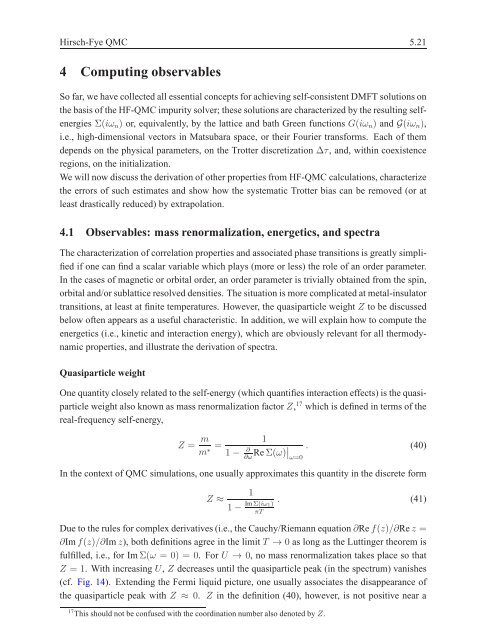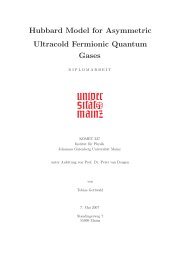5 Hirsch-Fye quantum Monte Carlo method for ... - komet 337
5 Hirsch-Fye quantum Monte Carlo method for ... - komet 337
5 Hirsch-Fye quantum Monte Carlo method for ... - komet 337
You also want an ePaper? Increase the reach of your titles
YUMPU automatically turns print PDFs into web optimized ePapers that Google loves.
<strong>Hirsch</strong>-<strong>Fye</strong> QMC 5.21<br />
4 Computing observables<br />
So far, we have collected all essential concepts <strong>for</strong> achieving self-consistent DMFT solutions on<br />
the basis of the HF-QMC impurity solver; these solutions are characterized by the resulting selfenergies<br />
Σ(iωn) or, equivalently, by the lattice and bath Green functions G(iωn) and G(iωn),<br />
i.e., high-dimensional vectors in Matsubara space, or their Fourier trans<strong>for</strong>ms. Each of them<br />
depends on the physical parameters, on the Trotter discretization ∆τ, and, within coexistence<br />
regions, on the initialization.<br />
We will now discuss the derivation of other properties from HF-QMC calculations, characterize<br />
the errors of such estimates and show how the systematic Trotter bias can be removed (or at<br />
least drastically reduced) by extrapolation.<br />
4.1 Observables: mass renormalization, energetics, and spectra<br />
The characterization of correlation properties and associated phase transitions is greatly simplified<br />
if one can find a scalar variable which plays (more or less) the role of an order parameter.<br />
In the cases of magnetic or orbital order, an order parameter is trivially obtained from the spin,<br />
orbital and/or sublattice resolved densities. The situation is more complicated at metal-insulator<br />
transitions, at least at finite temperatures. However, the quasiparticle weight Z to be discussed<br />
below often appears as a useful characteristic. In addition, we will explain how to compute the<br />
energetics (i.e., kinetic and interaction energy), which are obviously relevant <strong>for</strong> all thermodynamic<br />
properties, and illustrate the derivation of spectra.<br />
Quasiparticle weight<br />
One quantity closely related to the self-energy (which quantifies interaction effects) is the quasiparticle<br />
weight also known as mass renormalization factorZ, 17 which is defined in terms of the<br />
real-frequency self-energy,<br />
Z = m<br />
=<br />
m∗ 1<br />
1− ∂<br />
∂ω ReΣ(ω)� � ω=0<br />
. (40)<br />
In the context of QMC simulations, one usually approximates this quantity in the discrete <strong>for</strong>m<br />
Z ≈<br />
1<br />
1− ImΣ(iω1)<br />
πT<br />
. (41)<br />
Due to the rules <strong>for</strong> complex derivatives (i.e., the Cauchy/Riemann equation∂Ref(z)/∂Rez =<br />
∂Imf(z)/∂Imz), both definitions agree in the limitT → 0 as long as the Luttinger theorem is<br />
fulfilled, i.e., <strong>for</strong> ImΣ(ω = 0) = 0. For U → 0, no mass renormalization takes place so that<br />
Z = 1. With increasing U, Z decreases until the quasiparticle peak (in the spectrum) vanishes<br />
(cf. Fig. 14). Extending the Fermi liquid picture, one usually associates the disappearance of<br />
the quasiparticle peak with Z ≈ 0. Z in the definition (40), however, is not positive near a<br />
17 This should not be confused with the coordination number also denoted byZ.













